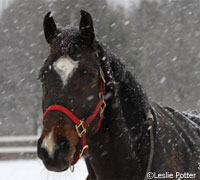 Growing up in Northwest Indiana, where lake effect snow is a way of life, one of the things that worried me most about winter was my horse. Whenever the weatherman predicted a snowstorm approaching, I fretted over whether he was sheltered and warm enough. When anxiety reached hysteria, I would jump in my car for a treacherous drive on icy roads in order to outfit my horse with an extra blanket, a hood and some standing wraps for good measure. Leaving my horse to awkwardly stretch his multi-layered neck into his bucket to slurp down a steaming hot bran mash, I would slip and slide my way back home, with feet that felt like twin blocks of ice and numb fingers that required painful attempts at thawing.
Growing up in Northwest Indiana, where lake effect snow is a way of life, one of the things that worried me most about winter was my horse. Whenever the weatherman predicted a snowstorm approaching, I fretted over whether he was sheltered and warm enough. When anxiety reached hysteria, I would jump in my car for a treacherous drive on icy roads in order to outfit my horse with an extra blanket, a hood and some standing wraps for good measure. Leaving my horse to awkwardly stretch his multi-layered neck into his bucket to slurp down a steaming hot bran mash, I would slip and slide my way back home, with feet that felt like twin blocks of ice and numb fingers that required painful attempts at thawing.
Winter Wrap-up
Horses begin to grow their coats when the days get shorter, not as the temperature drops as many believe. This is because a horse must begin to develop his coat long before winter sets in. It works like this: As the days shorten and the retinas receive fewer hours of daylight, they trigger the brain to release extra melatonin, a hormone that prompts the hair follicles to produce more hair. Many western show barns use this light response to their advantage. Since body clipping can detract from the horse’s appearance, particularly when it comes to halter horses, owners and trainers install electric lights in stalls so that coats stay short for the winter show season.
But why is it that during a cold snap your horse suddenly appears fluffier? Although it may seem that his hair multiplied overnight, it really didn’t. That fuller coat is just your horse’s clever way of creating insulation. The hairs lift up to trap the warm air against his skin. (Even the shorn hairs on a body clipped horse will lift up if he feels cold, giving his coat a velvety texture.) If you blanket your horse you’ll discover that his hair will lie flat. If you leave the blanket off, his hairs will eventually fluff up and look longer. The coat is the same length; it’s just raised to try to keep the warmth in.
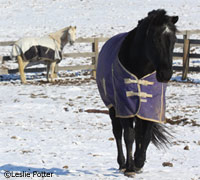 How heavy a horse’s coat grows can vary. Some of this variation is based on climate conditions in the part of the world where his breed was developed. Warmbloods and coldbloods, many of which were developed in Northern Europe, can get fairly heavy winter coats, says Sue McDonnell, Ph.D., an animal behaviorist at the New Bolton Center at the University of Pennsylvania and author of Equid Ethogram, A Practical Field Guide to Horse Behavior. But McDonnell explains that even thin-coated breeds can grow a coat given the opportunity. “One amazing observation that I have discussed with other reproduction specialists is that foals born in winter have coats at birth that are heavier than those of summer born foals. Physiologically, the foals’ coats must be regulated, probably by factors related to those that regulate the mares’ coats.”
How heavy a horse’s coat grows can vary. Some of this variation is based on climate conditions in the part of the world where his breed was developed. Warmbloods and coldbloods, many of which were developed in Northern Europe, can get fairly heavy winter coats, says Sue McDonnell, Ph.D., an animal behaviorist at the New Bolton Center at the University of Pennsylvania and author of Equid Ethogram, A Practical Field Guide to Horse Behavior. But McDonnell explains that even thin-coated breeds can grow a coat given the opportunity. “One amazing observation that I have discussed with other reproduction specialists is that foals born in winter have coats at birth that are heavier than those of summer born foals. Physiologically, the foals’ coats must be regulated, probably by factors related to those that regulate the mares’ coats.”
So the upshot is, when left to his devices, a horse will create his own protection, and a natural winter coat is an amazingly protective feature. The long outer hairs form channels that help repel water. And if you separate those hairs, underneath there is a layer of dry hair and skin. “The downy undercoat has very good insulating properties,” McDonnell says. “You can often see snow sitting on the backs of horses and especially ponies for many hours after a heavy snowfall. Just an inch or so below that snow, which is 32 degrees or lower, the body temperature is about 100 degrees, and the snow is not melting. That layer of hair coat is preventing heat transfer from the body. When you flatten that layer with a blanket, for example, you will see that the snow on top of the blanket melts.” On a horse with a natural winter coat, too heavy of a blanket can effectively reduce the insulating properties of the hair coat.
“Lots of things affect the thermoneutral zone for any given animal, including wind, humidity, activity of the animal and nutritional status,” McDonnell says. The thermoneutral zone is the range of environmental temperature at which the animal uses minimal energy to maintain body temperature—the “ideal” temperature for comfort. “But as a general concept, I have always been so impressed with animals’ natural winter coats. The thermoneutral zone in winter is quite low, around freezing or below freezing.”
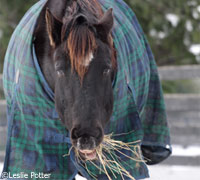 Central Heating
Central Heating
Horse people who live in the Great White North know that when it’s a super cold day they can warm their hands by pushing them deep inside a horse’s coat. The heat you feel is produced inside the horse’s digestive tract, which is stoked by fermentation. It’s true; a horse has his own little central heating system. You can help keep that warmth flowing by providing the right materials. For the horse, this means fiber.
“When a horse digests long-stem fiber (hay), microbial fermentation occurs and heat is created,” says Brian Nielsen, Ph.D., professor and researcher in equine exercise physiology and nutrition at Michigan State University. “This has a benefit to the horse in times of cold weather because fiber is digested slowly, and heat is sustained for quite a long time.” Although Nielsen says that it’s difficult to pinpoint a precise amount to feed, an extra flake of hay on a cold day is a good rule of thumb.
Calories gained from fats and grains, such as corn, can also help a horse stay warm but won’t produce long, sustained heat. “A horse will use that feed for whatever purpose he needs, whether it is running a race or keeping warm,” Nielsen says. “It’s all calories. But it’s fiber that automatically generates heat.”
A hot bran mash will heat a horse up for a few minutes, merely because it’s a hot dish, but it won’t be enough to make a difference. The benefit of the mash is that it will help put a little more water into the animal. “The more water you can get into a horse in the winter the better,” Nielsen says. “That’s why colic seems to be more prevalent in the cold. We get a cold snap, and horses won’t drink as much water, so impactions seem to happen.”
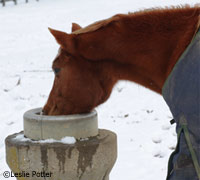 Water Heater
Water Heater
To help your horse keep his body temperature up, you must make sure that his digestion is able to function the best it can. And that means making sure he has a readily available source of drinkable water and that, Nielsen says, does not include snow. “A horse would not be taking in enough water if you rely on him eating snow. Also, a horse will use up a lot of calories getting that snow from the solid state to the liquid state, and so it will be that much harder for your horse to keep his weight on.” Horses are much less likely to drink cold water as tepid water. Most water tank heaters keep the water a few degrees above freezing, and as long as there isn’t any ice floating in the water, it should be fine. But if you have worries about a particular horse getting enough water, you can warm the water up to encourage him to drink more.
Winter Tips
Keeping your horse healthy in winter takes some careful consideration and planning. To turn out or not to turn out is one winter concern for horse owners. But when a horse has a choice he will often choose to remain outside, even in the most inclement conditions. “One of the best pictures I have of my horses was taken in 1997 after a horrible blizzard,” Nielsen says. “The horses could have gone into the barn, but they chose to stand out in the storm, haunches turned into the wind. They were pretty content.”
“Behaviorally, horses find the best weather conditions in their environment,” McDonnell adds. “They stand along stream banks, where the temperatures are warmer due to the flowing water, and the wind is quieter due to the protection of the banks. They huddle together with their backs to the wind.”
If you choose to keep your horses outside during the winter, it is still your responsibility to give your animals a place where they can get out of the snow and wind if they desire.
The main concern with turnout in icy conditions is for stabled horses. Slipping can be more of an issue because your stabled horse, sniffing freedom and fresh air, will be more likely to tear around, fall on ice and injure himself. “The best way to manage this,” Nielsen says, “is to give them access to continual turnout. However, with stabled horses, regular turnout, or turnout after they’ve been ridden and are already a bit tired, will make it less likely that they are going to run around excessively and hurt themselves.”
Since ice can ball up in a horse’s shoes and make it difficult for him to walk, many people choose to remove shoes in the winter. Discuss this option with your farrier to determine what is best for your horse’s particular needs. “Unless it is critical for your horse to have shoes on,” Nielsen says, “he will be a lot better off in the winter if they are not put on.”
As for exercising your horse in winter, Nielsen points out, “One needs to keep in mind that if the horse gets hot and sweaty, you really need to be careful about cooling him out without getting him chilled.” He explains that deep snow can be hard on your horses’ tendons, so ride in good footing. “Also, given that most people don’t ride as consistently during the winter as they do in the summer, you have to be careful not to do too much given your horse’s level of fitness,” Nielsen adds.
So breathe a sigh of relief and get on with your own winter preparations. There is little need to dress your horse as though he is mounting an expedition to the North Pole or freeze yourself blue trying to lessen the season’s impact. With your horse’s natural abilities and a little helping hand from you, both of you can settle down and enjoy a warm, safe and happy winter.
Further Reading
Ten Winter Health Care Mistakes to Avoid
Ten Winter Feeding TIps
Horse Blanket Central
After experiencing 14 years of warm, sunny winters in California, and then five in the mild winters of southern England, Sharon Biggs will soon be returning to the icy cold conditions of Northwest Indiana where she will put her wisdom to good use.



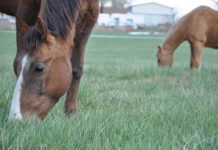



This is a great article. Thank you!
I just read an article on winter care of your horse. Brilliant and logical. I wish I could give a copy of this article to everyone who needlessly frets and overblankets during the winter!
good article
Another great article! I don’t have any horses yet, but when I do they and my family and myself will have to content with very cold temperatures during the winter months. This information is very helpful in that I will be less tempted to fuss over my future equine friends as much. Thankyou for the educational information, very helpful!
i agree to a certain extent but not all because they do get cold because i have seen them stand there and shiver from head to foot so they do get cold but we don’t have to worry about ours for we have barns for all of our horses and they will get sick out in it if the weather is to bad. so i can tell you they do get cold we have about twenty horses so we know. sincerely sugarbritches
I am fortunate that my senior horses don’t mind being in thier stalls and in fact one of them actually prefers it. My pony and minis are hardier but I still prefer to keep them in the barn during really cold, windy, or icy days. I havnt blanketed anyone in several years but do provide extra hay and add hot water to the buckets to encourage them to drink. Good article, though. I know I for one have lost many a nights sleep worrying about what to do for them when the weather gets bad but when I put them in the barn, I can litteraly feel the stress melt away.
Luckily we have semi-mild winters. it freezes, but it NEVER snows. so my horses are usually blanked with a light waterproof sheet, and on the colder nights, with a fleece underneath.(: